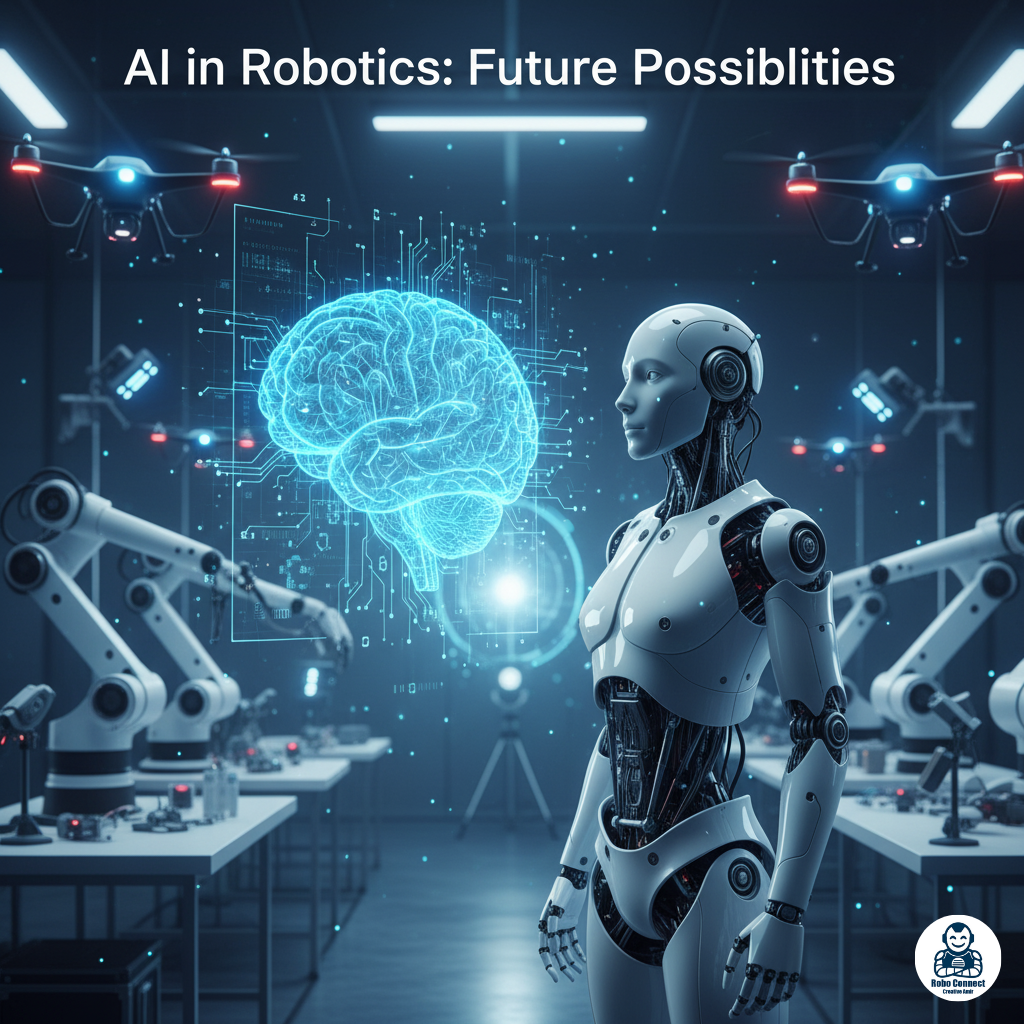Introduction
Robots are already part of our lives — in factories, hospitals, homes, and even in space. But what’s pushing robotics into next-level intelligence and autonomy is Artificial Intelligence (AI).
AI helps robots do more than just follow pre‑programmed paths — it enables them to learn, adapt, and make decisions in real‑time.
In this blog, we’ll explore:
- The role of AI in robotics today.
- Real examples of AI‑powered robots.
- Future possibilities and challenges in this exciting field.
What is AI in Robotics?
Robotics = The physical body (motors, sensors, mechanical design).
Artificial Intelligence = The “brain” (cognition, learning, decision making).
When combined, you get intelligent robots that:
- Sense the environment.
- Understand it with AI.
- Act accordingly without needing step‑by‑step manual coding.
How AI is Used in Robots Today
- Computer Vision
- Robots use cameras + AI algorithms (CNNs, deep learning) to “see” objects.
- Example: Self‑driving cars recognizing traffic lights, pedestrians.
- Natural Language Processing
- Robots interact with humans via voice.
- Example: Alexa‑style robots, customer service bots in stores.
- Machine Learning
- Robots learn from past actions → become better over time.
- Example: A warehouse robot that optimizes picking routes automatically.
- Reinforcement Learning
- Robots trained via trial and error (like teaching a child).
- Example: Quadruped robots learning to walk over uneven terrain.
- Autonomy in Navigation
- Drones and cars use AI navigation + SLAM (Simultaneous Localization and Mapping).
Examples of AI in Modern Robots
- Boston Dynamics’ Spot → Learns terrain, avoids obstacles, used for inspection.
- Tesla’s Autopilot & Optimus → Cars with semi‑autonomous driving, humanoid robot development.
- Surgical Robots (Da Vinci System) → Enhanced with machine vision for precise operations.
- Amazon’s Warehouse Robots → AI algorithms optimize package sorting + delivery.
- SoftBank’s Pepper Robot → Interacts with humans, recognizes emotions via AI.
Future Possibilities of AI in Robotics
- Fully Autonomous Vehicles
- Self‑driving cars and drones everywhere for logistics, taxis, and delivery.
- Healthcare & Elderly Care Robots
- AI caregivers performing daily tasks, providing companionship, monitoring health.
- Smarter Manufacturing Robots
- Adaptive, AI‑driven factory bots → fast switching between product lines.
- Personal Assistants and Domestic Robots
- Next‑gen home robots: not just cleaning (like Roomba), but cooking meals, learning your habits.
- Space Exploration Robots
- Self‑learning rovers on Mars or Europa → identifying signs of life without human input.
- Collaborative Humanoid Robots
- Robots working side‑by‑side with humans in offices, retail, and home settings.
- ⚕ AI‑Driven Prosthetics & Exoskeletons
- Learning user’s motion habits → personalized rehabilitation and strength augmentation.
Challenges Ahead
- Ethical Concerns → Should AI robots replace human jobs? Who is responsible if AI fails?
- Safety → AI decisions must be robust in critical tasks (surgery, autonomous cars).
- Cost & Accessibility → Making AI robotics affordable for schools & individuals.
- Security → AI robots connected to internet = potential hacking risk.
Why It Matters for Beginners
If you’re learning Arduino, Raspberry Pi, or robotics now — AI + Robotics is your future destination.
Today, you can start:
- With sensors, motors, and robot cars (Arduino/ESP projects).
- Move to Raspberry Pi + Python + AI libraries (OpenCV, TensorFlow Lite).
- Eventually → Build smart robots that see, think, and act.
FAQs
Q1: Will AI replace humans in robotics?
No. AI will help robots collaborate with humans, not replace them. Human creativity, empathy, problem‑solving remain unique.
Q2: Can hobbyists use AI in small robots?
Yes! Use Raspberry Pi with camera + Python OpenCV to make AI line follower or face‑tracking robots.
Q3: What skills do beginners need for AI + Robotics?
- Basic electronics (Arduino/ESP).
- Python programming.
- Linux basics (for Raspberry Pi).
- AI libraries (OpenCV, TensorFlow).
Conclusion
AI is revolutionizing robotics — making robots not only faster and stronger, but smarter and more adaptable.
From self‑driving cars to AI‑powered medical bots and even personal home assistants, the possibilities are enormous.
For students and makers: start combining robotics kits + basic AI tools today. The skills you learn now will power the robotic future.

